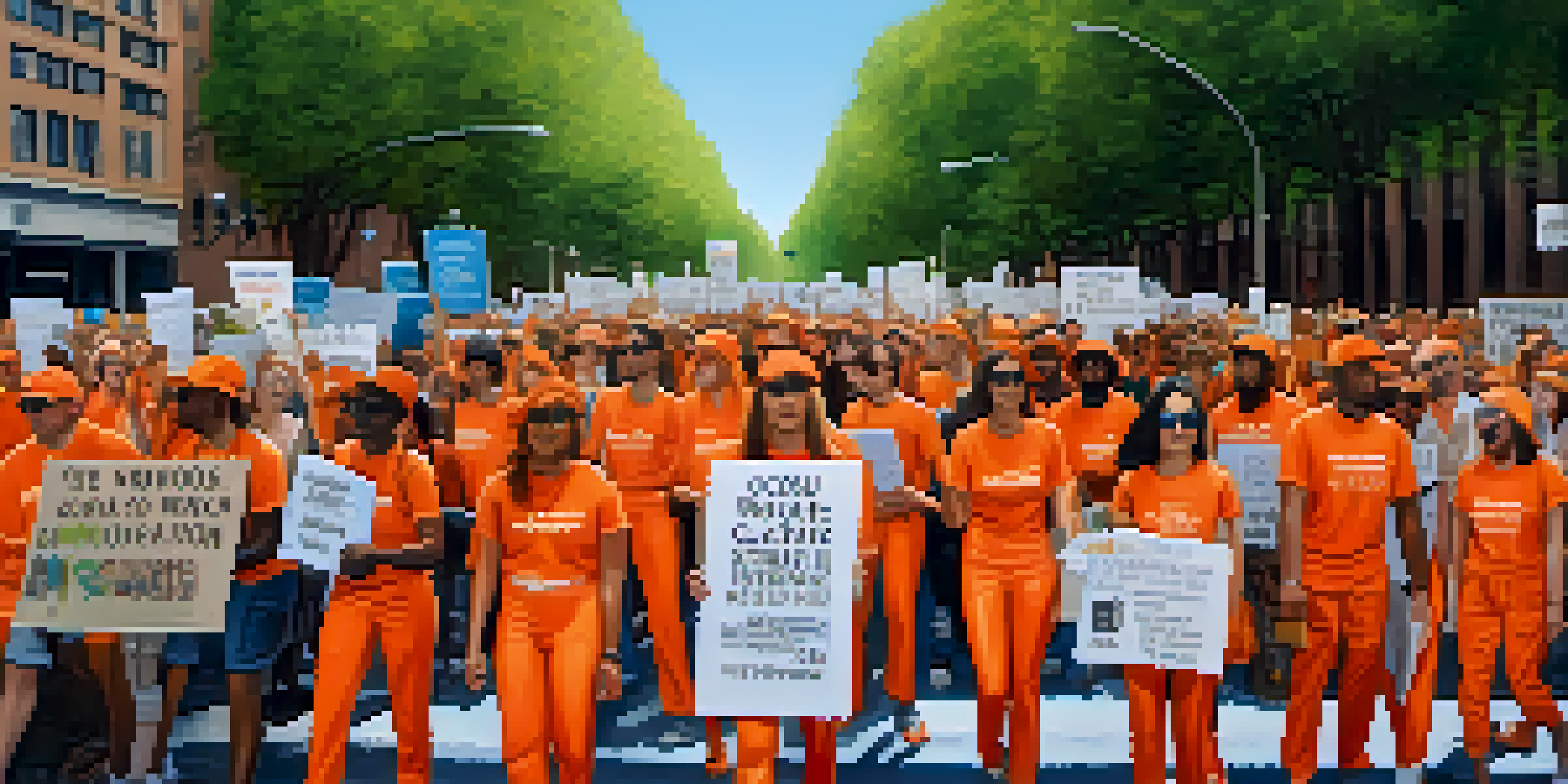The Power of Color in Fashion as a Political Symbol

Understanding Color Theory in Fashion and Politics
Color theory is a fascinating aspect of design that can evoke emotions and convey messages. In fashion, colors are not just aesthetic choices; they can symbolize political ideologies and movements. For instance, the use of red often signifies revolution or anger, while blue may represent calmness and stability.
Color is the keyboard, the eyes are the harmonies, the soul is the piano with many strings.
This interplay between color and meaning has a significant impact on how garments are perceived. When individuals wear colors associated with particular causes, they send a clear message about their beliefs. For example, the pink hue of the 'Women’s March' became a symbol of solidarity and resistance.
Understanding color theory helps us decode these visual messages. By being aware of the meanings behind different colors, we can grasp the deeper significance of fashion choices in political contexts.
Historical Context: Color as a Political Tool
Throughout history, color has been a potent political tool, used to rally people around a cause. One notable example is the suffragette movement, where purple, white, and green were adopted to represent dignity, purity, and hope. These colors became synonymous with the fight for women's voting rights.

Similarly, the use of color in various civil rights movements has been striking. The black power movement adopted the color black to symbolize strength and pride, creating a powerful visual identity. These choices resonate not only with the participants but also with the broader public.
Color as a Political Symbol
Colors in fashion convey powerful political messages, such as pink representing solidarity in the 'Women’s March.'
By examining these historical contexts, we can see how color acts as a rallying cry, fostering unity and increasing visibility for political causes. It encourages individuals to wear their beliefs proudly, turning fashion into a form of activism.
Modern Examples of Color in Political Fashion
In today's world, the connection between color and political expression continues to thrive. For instance, the vibrant orange worn by protestors during climate marches symbolizes urgency and the need for action. It’s a visual cue that signals a collective demand for change.
Fashion is the armor to survive the reality of everyday life.
The LGBTQ+ community also utilizes color effectively, particularly with the rainbow flag. Each color on the flag represents different aspects of diversity and inclusion, making it a powerful emblem in the fight for equality. This colorful representation fosters a sense of belonging and solidarity.
These modern examples illustrate that fashion is not just about personal style; it’s also a platform for political expression. Through conscious color choices, individuals can communicate their beliefs without saying a word.
The Psychology of Color in Political Messaging
The psychology of color plays a crucial role in how political messages are received. Different colors evoke different feelings; for example, green is often associated with growth and renewal, making it a popular choice for environmental causes. This psychological impact can greatly influence public perception.
Moreover, colors can create a sense of urgency or calmness. Bright colors like yellow can catch attention and energize, while deeper shades like navy can evoke trust and authority. Understanding these psychological effects helps activists choose the most effective colors for their campaigns.
Historical Use of Color
Throughout history, color has served as a rallying point for movements, like the suffragette movement's use of purple, white, and green.
By tapping into color psychology, political fashion can enhance its message and resonate more deeply with audiences. This understanding empowers individuals to make deliberate choices that amplify their political statements.
Fashion Designers as Political Commentators
Fashion designers have increasingly embraced their roles as political commentators, using their platforms to address social issues. Designers like Vivienne Westwood and Balenciaga have created collections that incorporate bold colors symbolizing their stances on climate change and social justice.
These designers often challenge traditional norms and use their creations to spark conversations. By infusing political messages into fashion, they encourage consumers to think critically about the implications of their choices. Fashion becomes a medium for storytelling, often reflecting the zeitgeist of the times.
As designers push boundaries, they demonstrate that fashion can be a powerful tool for advocacy. Their work invites others to engage with political issues through the lens of style, ultimately shaping societal discourse.
The Role of Social Media in Color and Politics
Social media has transformed how color and politics intersect, allowing movements to gain visibility rapidly. Hashtags like #BlackLivesMatter and #MeToo often feature specific color palettes that become symbols of solidarity and support. This digital landscape amplifies the impact of color in political discourse.
Platforms like Instagram enable users to share their fashion choices, infusing color into their advocacy. Users can express their political identities through their outfits, creating a visual narrative that resonates with their followers. This democratization of fashion empowers individuals to participate in movements.
Social Media Amplifies Color Impact
Social media platforms have transformed how color is used in political fashion, allowing users to express solidarity through visual narratives.
Thus, social media serves as a catalyst for change, blending fashion with political activism. The colors chosen by users contribute to a larger conversation, highlighting the vibrant ways individuals can express their beliefs.
Future Trends: Color in Political Fashion
Looking ahead, the role of color in political fashion is likely to evolve further. As societal issues become more complex, we may see new color trends emerging that symbolize these changes. For instance, shades representing mental health awareness are gaining traction, reflecting a growing conversation around mental wellness.
Additionally, sustainability may drive color choices, with eco-friendly dyes and materials becoming more prominent. This shift not only aligns with environmental goals but also creates a richer narrative around fashion’s impact on the planet. The colors we choose may soon reflect our commitment to sustainability.

The future is bright for color in political fashion, as individuals continue to seek ways to express their beliefs through their style. This evolution will keep the dialogue open and vibrant, ensuring that fashion remains a relevant platform for political expression.